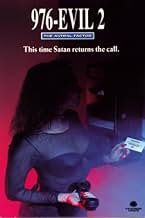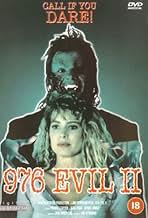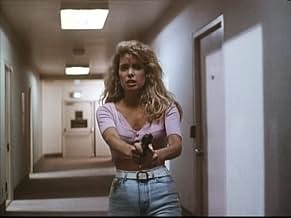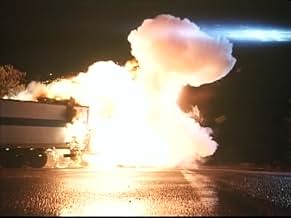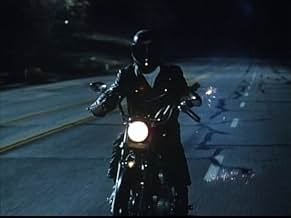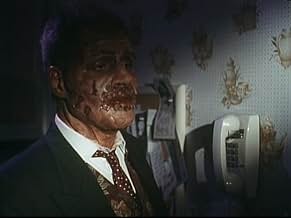VALUTAZIONE IMDb
4,3/10
1956
LA TUA VALUTAZIONE
Aggiungi una trama nella tua linguaA seemingly harmless telephone service endows an evil teacher with powers from beyond the grave.A seemingly harmless telephone service endows an evil teacher with powers from beyond the grave.A seemingly harmless telephone service endows an evil teacher with powers from beyond the grave.
Patrick O'Bryan
- Spike
- (as Pat O'Bryan)
Philip McKeon
- Taylor
- (as Phil McKeon)
George 'Buck' Flower
- Turrell
- (as Buck Flower)
Trama
Lo sapevi?
- QuizBrigette Nielsen was cast after she met director Jim Wynorski at a party. At the party, the two of them played a round of pool together with a wager: if Nielsen won, Jim would "put on a maid's outfit and clean her house" but if Wynorski won, Nielsen would work on the film for one day.
- BlooperWhen Lawlor is being abducted by the ghost Grubeck, it is very obvious that a person in a black ski mask and black clothes is driving the car.
- Citazioni
Zuzu Bailey: Look, Daddy! Every time you hear a bell, a zombie takes a soul to hell.
- ConnessioniEdited into Ghoulies IV - Passioni infernali (1994)
Recensione in evidenza
Horror sequels are a curious breed. Often, they struggle to capture the essence of what made their predecessors successful, or they amplify the wrong elements in a misguided attempt to outdo the original. "976-Evil II" (1991) is one such film-a movie that exists in the shadow of its predecessor but ends up being a fascinatingly chaotic and campy ride. Directed by Jim Wynorski, a prolific filmmaker known for his exploitation films, this sequel dials into a horror subgenre that revels in its own absurdity, delivering a mixed bag of supernatural thrills, low-budget effects, and unintentional comedy.
Plot Overview
"976-Evil II" follows the cursed phone line concept from the original film but takes it in an entirely different, and somewhat nonsensical, direction. The story centers around Robin (Debbie James), a college student who starts experiencing terrifying visions after answering a call from the demonic hotline. Enter Grubeck (Rene Assa), a sadistic college dean who gains the ability to astral project and commit murders thanks to the satanic power of the 976-evil hotline. As Robin teams up with Spike (Patrick O'Bryan), a returning character from the first film, they must confront Grubeck's ghostly rampage before he completes his sinister plans.
Aesthetics and Direction: Wynorski's direction is a testament to the "more is more" philosophy that dominated low-budget horror in the early 90s. The film is a hodgepodge of horror tropes, from possession and slasher elements to outlandish supernatural occurrences. The effects are a particular highlight (or lowlight, depending on your perspective)-with Grubeck's ability to astral project leading to a series of bizarre death scenes that feel more like a fever dream than a cohesive narrative.
One particularly memorable scene involves a victim being trapped inside a television, forced to live through a warped version of "It's a Wonderful Life" that ends in her brutal demise. It's moments like these where the film's absurdity reaches a peak, offering a glimpse into the kind of surreal horror that can only come from a director unafraid to push the boundaries of good taste.
Visually, "976-Evil II" is drenched in neon lighting, fog machines, and quick cuts, creating a disorienting atmosphere that mirrors the disjointed nature of the plot.
**Performances:** The acting in "976-Evil II" is a mixed bag, with some performances adding to the film's campy charm while others fall flat. Rene Assa as Grubeck chews the scenery with relish, delivering lines with a menacing glee that makes his character's descent into madness all the more entertaining. His performance is one of the film's saving graces, providing a villain who is both ridiculous and genuinely unsettling.
Debbie James, as the film's final girl, brings a certain vulnerability to Robin, though her character is often overshadowed by the over-the-top events surrounding her. Patrick O'Bryan reprises his role as Spike, but his character feels more like a plot device than a fully fleshed-out protagonist. He's the link to the original film, yet he spends most of the movie reacting to the insanity around him rather than driving the plot forward.
The tone is where the movie truly sets itself apart from its predecessor. While the original "976-Evil" (1988), directed by Robert Englund of Freddy Krueger fame, had a darker and more serious approach to its horror, the sequel veers into outright camp. This shift in tone makes "976-Evil II" feel less like a continuation and more like a parody of the original. The film's blend of horror and humor doesn't always work, leading to moments that are more confusing than scary. However, for fans of B-movies, this tonal inconsistency can be part of the film's appeal.
Cultural Impact and Legacy: In the grand scheme of horror cinema, "976-Evil II" is a footnote-an oddity that's more likely to be found in a midnight movie marathon than in any serious discussion of the genre. Yet, it's precisely this obscurity that gives the film its cult status. Like many low-budget horror sequels of its time, "976-Evil II" appeals to a niche audience who revel in its absurdity, its flaws, and its unapologetic embrace of the ridiculous.
The film also serves as a reminder of the creative risks taken by directors like Wynorski, who were willing to push the boundaries of what horror could be, even if the results were often more laughable than terrifying. In a way, "976-Evil II" is a celebration of the excesses of early 90s horror, a time when filmmakers were experimenting with new ideas, technologies, and ways to shock audiences-no matter how bizarre the outcome.
Conclusion: "976-Evil II" is not a good film by traditional standards. It's poorly paced, questionably acted, and the plot is a disjointed mess. But that's exactly what makes it such a fascinating watch. For fans of schlocky, so-bad-it's-good cinema, this sequel offers a treasure trove of outrageous moments and unintentional comedy that's hard to find in today's more polished horror fare.
If you're looking for a coherent, genuinely scary movie, "976-Evil II" will disappoint. But if you're in the mood for a surreal, campy trip through the wild world of early 90s horror, this film might just be your perfect midnight dial-in. Whether you love it or hate it, "976-Evil II" is a film that demands to be seen-if only to be believed.
Plot Overview
"976-Evil II" follows the cursed phone line concept from the original film but takes it in an entirely different, and somewhat nonsensical, direction. The story centers around Robin (Debbie James), a college student who starts experiencing terrifying visions after answering a call from the demonic hotline. Enter Grubeck (Rene Assa), a sadistic college dean who gains the ability to astral project and commit murders thanks to the satanic power of the 976-evil hotline. As Robin teams up with Spike (Patrick O'Bryan), a returning character from the first film, they must confront Grubeck's ghostly rampage before he completes his sinister plans.
Aesthetics and Direction: Wynorski's direction is a testament to the "more is more" philosophy that dominated low-budget horror in the early 90s. The film is a hodgepodge of horror tropes, from possession and slasher elements to outlandish supernatural occurrences. The effects are a particular highlight (or lowlight, depending on your perspective)-with Grubeck's ability to astral project leading to a series of bizarre death scenes that feel more like a fever dream than a cohesive narrative.
One particularly memorable scene involves a victim being trapped inside a television, forced to live through a warped version of "It's a Wonderful Life" that ends in her brutal demise. It's moments like these where the film's absurdity reaches a peak, offering a glimpse into the kind of surreal horror that can only come from a director unafraid to push the boundaries of good taste.
Visually, "976-Evil II" is drenched in neon lighting, fog machines, and quick cuts, creating a disorienting atmosphere that mirrors the disjointed nature of the plot.
**Performances:** The acting in "976-Evil II" is a mixed bag, with some performances adding to the film's campy charm while others fall flat. Rene Assa as Grubeck chews the scenery with relish, delivering lines with a menacing glee that makes his character's descent into madness all the more entertaining. His performance is one of the film's saving graces, providing a villain who is both ridiculous and genuinely unsettling.
Debbie James, as the film's final girl, brings a certain vulnerability to Robin, though her character is often overshadowed by the over-the-top events surrounding her. Patrick O'Bryan reprises his role as Spike, but his character feels more like a plot device than a fully fleshed-out protagonist. He's the link to the original film, yet he spends most of the movie reacting to the insanity around him rather than driving the plot forward.
The tone is where the movie truly sets itself apart from its predecessor. While the original "976-Evil" (1988), directed by Robert Englund of Freddy Krueger fame, had a darker and more serious approach to its horror, the sequel veers into outright camp. This shift in tone makes "976-Evil II" feel less like a continuation and more like a parody of the original. The film's blend of horror and humor doesn't always work, leading to moments that are more confusing than scary. However, for fans of B-movies, this tonal inconsistency can be part of the film's appeal.
Cultural Impact and Legacy: In the grand scheme of horror cinema, "976-Evil II" is a footnote-an oddity that's more likely to be found in a midnight movie marathon than in any serious discussion of the genre. Yet, it's precisely this obscurity that gives the film its cult status. Like many low-budget horror sequels of its time, "976-Evil II" appeals to a niche audience who revel in its absurdity, its flaws, and its unapologetic embrace of the ridiculous.
The film also serves as a reminder of the creative risks taken by directors like Wynorski, who were willing to push the boundaries of what horror could be, even if the results were often more laughable than terrifying. In a way, "976-Evil II" is a celebration of the excesses of early 90s horror, a time when filmmakers were experimenting with new ideas, technologies, and ways to shock audiences-no matter how bizarre the outcome.
Conclusion: "976-Evil II" is not a good film by traditional standards. It's poorly paced, questionably acted, and the plot is a disjointed mess. But that's exactly what makes it such a fascinating watch. For fans of schlocky, so-bad-it's-good cinema, this sequel offers a treasure trove of outrageous moments and unintentional comedy that's hard to find in today's more polished horror fare.
If you're looking for a coherent, genuinely scary movie, "976-Evil II" will disappoint. But if you're in the mood for a surreal, campy trip through the wild world of early 90s horror, this film might just be your perfect midnight dial-in. Whether you love it or hate it, "976-Evil II" is a film that demands to be seen-if only to be believed.
- rdrivenimpala
- 28 ago 2024
- Permalink
I più visti
Accedi per valutare e creare un elenco di titoli salvati per ottenere consigli personalizzati
- How long is 976-Evil II?Powered by Alexa
Dettagli
- Tempo di esecuzione1 ora 33 minuti
- Colore
- Mix di suoni
- Proporzioni
- 1.85 : 1
Contribuisci a questa pagina
Suggerisci una modifica o aggiungi i contenuti mancanti

Divario superiore
By what name was 976 chiamata per il diavolo 2 (1991) officially released in Canada in English?
Rispondi
